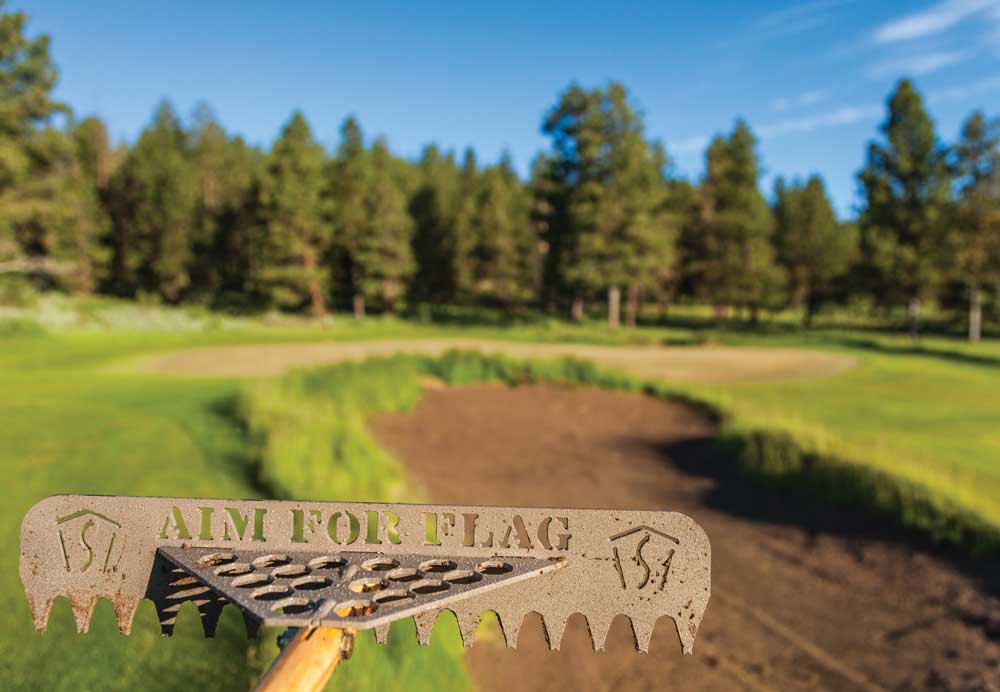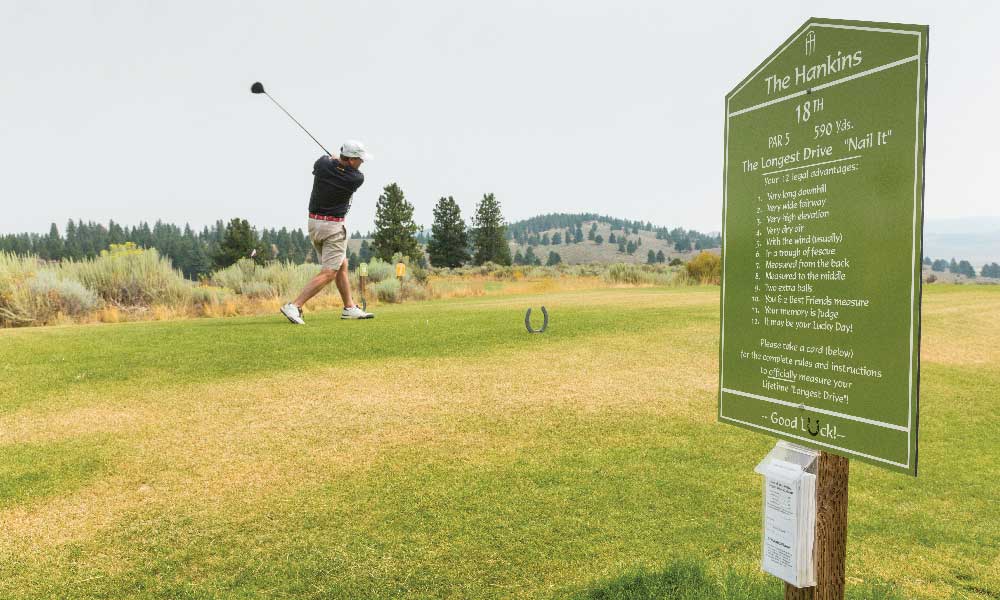This column features the author’s recollections of his 33 years as a golf writer. These installments stem from his many travels and experiences, which led to a gradual understanding that the game has many intriguing components, especially its people. This story caters to the themes of this issue of Golf Course Trades. It involves some of the “things” he’s found on golf courses.
Golf Furnishings & Stuff
On my many travels playing golf around the world I’ve seen all manner of paraphernalia on courses. Most aren’t in play (note the anecdote below for one memorable exception). Such items are often meant to embellish and represent the facility’s identity. They range from elementary to intricate, subdued to splashy, traditional to cutting-edge, small to quite large.
I’m not talking about the homemade signs sometimes found in residential yards abutting golf courses. These can be engaging and funny (“If your ball is here, take a lesson from the pro to correct that slice!”), or off-putting (“If your ball is in my yard, you’re out-of-bounds!”). Another favorite is seeing a sprinkler-head message at, say, the 400-yard mark, with the quip: “You’re dreaming.”
I’ve taken several trips to the annual PGA Merchandise Show in Orlando. My estimate is that half of the thousands of booths hype golf clubs, balls, soft goods, resorts, travel services, game-improvement systems, associations and the like. The remainder tout some sort of “furnishings”: tee blocks; signs identifying the hole number, length and par; ancillary signage, with some presumably used to warn golfers of chance encounters with crocodiles, alligators, water moccasins, rutting moose and temperamental brown bear mothers.
Other items include ornate starter stands; specialized garbage can containers with secure-able lids designed to foil foraging beasts; “amenity boxes” which hold pencils, scorecards, tees, ball markers, etc.; ball washers and consoles; benches; spike cleaners; bag stands and racks; the list goes on and on. The imaginations of the inventive folks who seek to make an honest buck – or millions – off their golf doodads are truly amazing. Not surprisingly, some of them lose their shirts. Case in point: a friend of mine once manufactured hundreds of hats with a tiny umbrella atop it.
At one of these international golf expos I spotted a solitary gentleman in a 10-x10 booth towered over by a wrought-iron, 25-foot-high clock tower. Curious, I went up and asked him about it. He rattled off the monolith’s specs: it weighed 25,000 pounds; each was individually built to order; and the one on display was “very difficult” to get into the Orange County Convention Center. I couldn’t help but smile at that assessment.
Oddly, right next door in a same-sized booth was an outfit marketing small plastic bags of cotton balls. I asked, “What are these for?” The reply was: “They’re for throwing into the air to test the wind direction.” Ohh-kay.
Tee blocks prove especially diverse in size, construction and symbolism. Last year I made three circuits around the very remote, six-hole Kinzua Hills Golf Course in the wilds of east-central Oregon. The nearest town is aptly named Fossil. If no one is about (the facility has just one part-time employee) golfers pay green fees on the honor system. A sign beside the steps that rise to the small clubhouse lists the rates. Next to it is a small box containing scorecards, pencils, blank forms upon which golfers enter the number of holes they’ll be playing, and small envelopes into which the money and form are inserted. I can assure you that none of these pay “system” items were purchased at a PGA Merchandise Show.

The tee blocks here are horseshoes. This makes sense since many Kinzua Hills golfers park their RVs and horse trailers in an on-site shaded glen for overnight stays. Most bring their own power carts, which are stored in a compartment separate from their equine friends or towed behind in a special trailer.
Also using horseshoe tees is Silvies Valley Ranch in nearby Seneca. This high-end resort stretching across a whopping 140,000 acres features a reversible 18-hole layout, pricey green/resort/spa/restaurant fees, and goats for caddies. The custom-made, goat-caddie “saddles” were created by Seamus Golf, a Portland-based manufacturer whose best-selling product is “fine wool headcovers.” When the coronavirus pandemic hit earlier this year, Seamus Golf retooled its operations to make hundreds of thousands of face masks that have been shipped to all 50 states and many countries.

Some courses opt for no-frills tee blocks. Typical of these are oversized orbs of differing colors (i.e., white, red, blue and black to reflect yardages – or in some foreign places, meters – on the scorecard). An embedded spike allows them to be yanked out of the ground and be quickly reinserted at new starting points. These are invariably made of hard plastic.
One memorable story involving this kind of tee “block” occurred at my Seattle club, Sand Point. During one of our Wednesday haggles, Jim, a fairly good golfer, drove a worm-burner at the second hole and his ball slammed directly into a white one of these markers. Unfortunately, the ball ricocheted straight back at high speed and hit him in the forehead. Poor Jim had no time to react and, stunned, dropped to his knees.
Undeterred, the retired fishing boat owner/captain – who spent six months a year plying the rugged, freezing seas around the Bering Strait in search of black cod and salmon – rose to his feet and played all 18 holes. When he came into the bar four hours later, Jim sported a shiny-red, golf-ball-sized bump on his head and a glum look. Aghast, a couple of doctors in our group immediately instructed the bartender to fill a plastic bag with ice cubes, which Jim dutifully applied to reduce the swelling. They also administered a few concussion tests. Though small in stature, Jim impressed upon us that he is one tough hombre. Thankfully, the injury proved superficial, except for a knot on his head and the wisecracks directed his way over the ensuing months.
Depending on the desires of a course owner, superintendent, general manager or head professional, there are literally hundreds of types of tee markers from which to choose. Some distributors offer custom-built units with exquisite detailing. I’ve seen finely-carved wood and brass tee markers depicting animals, the club’s rich heritage, and iconographs of the community. Many public golf courses have tee markers, benches and scorecards with advertising extolling the virtues of local businesses. Some are accompanied by a photo of the beaming proprietor.
Since the vast majority of golf furnishings reside out of doors, they need to offer a long life, resistance to fading and maintain their shape and utility while exposed to all manner of temperatures and weather conditions.
But a new phenomenon owing to the coronavirus pandemic has resulted in some heretofore unseen “furnishings”: hand-sanitizer dispensers, bright-yellow adhesive floor decals placed 6 feet apart for social distancing, and specialized cups for putting greens.
The latter area has seen equipment makers, distributors and golf course superintendents roll out an array of products. The intent of each is to prevent golfers from touching the flagstick or retrieving balls from the hole so as to not catch the virus or spread it to unsuspecting fellow players.
Options include adding spacers (called “noodles” in this nascent trade) at the base of flagsticks to keep the ball from sinking to the cup’s bottom (oh, how I miss that wonderful sound of a putt rattling into the hole!). A rubberized disc serves the same purpose (not my favorite; I swear I was robbed of a hole-in-one by one of these). Perhaps even worse is an aboveground “cup,” with supposedly “made” putts clanging against it. I can only imagine the arguments this model generates.
A particularly interesting gadget I saw recently was a hooked lever attached near the bottom of the flagstick. One such version is called the Golf Ball E-Z Lyft. No inserts are used. A golfer places his putter head into the hook (whatever you do, don’t touch the stick with your hands!) to pry out the flag and play golf just as we have for decades.
Maybe the USGA knew something the rest of us didn’t in 2019 when they made it legal – and scores post-able for handicap purposes – to either pull the flag or keep it in while putting. Now I know why that organization swears it’s “Good for the Game.”
Jeff Shelley has written and published nine books as well as numerous articles for print and online media over the past 32 years. Among his titles are three editions of “Golf Courses of the Pacific Northwest.” He also co-authored and published “Championships & Friendships: The First 100 Years of the Pacific Northwest Golf Association.” The Seattle resident co-founded the Northwest Golf Media Association in 1995, and served as the president of First Green, which is now part of the Golf Course Superintendents Association of America and its Environmental Institute of Golf.
Read other in Jeff’s Series of Making the Rounds – https://www.golfcoursetrades.com/author/jshelley/





















